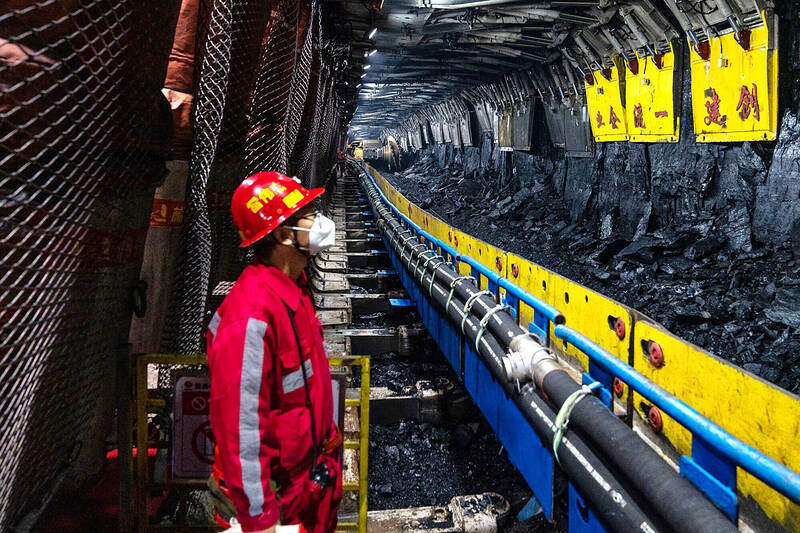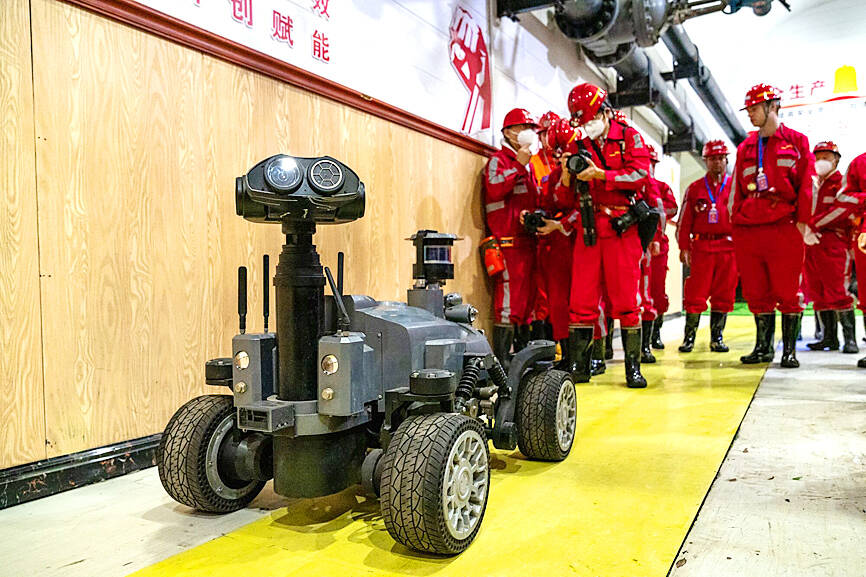One hundred meters underground inside a pit in northern China, miners extract lumps of coal with the flick of a finger on a smartphone, as the country tries to drag the traditionally dangerous and dirty work into the digital era.
The Hongliulin “intelligent mine” in coal-belt Shaanxi Province is a flagship facility in a drive to modernize China’s thousands of coal mines, even as the nation pledges to peak greenhouse gas emissions by 2030.
China is the world’s biggest emitter of the pollutants driving climate change, and its promises to curb them are essential to keeping global temperature rises below 2°C.

Photo: Bloomberg
However, mine digitalization — which aims to improve safety and productivity — shows the continued importance of coal in a country that last year produced nearly 60 percent of its electricity from the fossil fuel.
Smart mines are common in other coal-producing nations such as Canada, but China has lagged and the government is aiming to achieve basic digitalization of all mines by 2035.
On a tour organized by telecom giant Huawei Technologies Co (華為) — whose technology underpins the changes at Hongliulin — journalists saw sensors, smart cameras and 5G relay boxes crisscrossing the facility.

Photo: Bloomberg
Inside a control room crammed with screens displaying numbers, graphs and images, technical manager Wang Lei (王磊) said he could monitor the air, temperature and other data in real time.
Digitalization “has reduced the intensity of our work,” said 33-year-old electrician Ruan Banlin, who has worked in the mine for 10 years.
Huawei said the new methods had increased output per shift by almost one-third.
That is good news for China’s energy grid — but not the planet.
Greenpeace this week reported that Beijing has approved a surge in coal power this year, green-lighting as much in the first three months as for the whole of 2021.
“We’re seeing a decrease in the number of coal mines, while the clustering of production increases along with total output,” Greenpeace East Asia climate and energy campaigner Xie Wenwen (謝雯文) said.
Asked about smart mining, Xie said it should be scrutinized closely.
“Obviously the safest thing we can do is leave the coal in the ground. That goes for climate as well as other risks,” she said.
China had 4,400 coal mines at the end of last year, official data showed.
If it delivers on emissions pledges, those mines would be operating at minimum capacity and at a loss over the coming decades, Greenpeace said.
Huawei’s involvement suggests China is betting on coal retaining its importance in fuel supply for years.
The company — whose net profit fell 69 percent year-on-year last year — is diversifying after US sanctions over cybersecurity and espionage concerns hammered its business.
Xu Jun (徐軍), head of mining digitalization for Huawei, said that many competitors were setting up teams in the field.
“The investment in smart mining solutions is not contradictory to Huawei’s investment in clean energy,” the firm said.
“Worldwide, coal and clean energy use will coexist for a long time. The trend of intelligence in related industries is unstoppable,” it said.
Safety is a major concern in the industry, where last year 245 people died in 168 incidents, official data showed.
In February, a mine collapse in northern China killed about 50 people.
At Hongliulin, data on extraction, miner location and danger detection is centralized on a system designed to eliminate problems caused by human error and miscommunication.
Instead of people, robots patrol and inspect the dark and narrow underground corridors.
“It is much better now,” Ruan said. “The underground mine is almost as safe as the ground.”
The management says the underground team has been cut 40 percent — although not the overall workforce — and only essential maintenance miners descend into the pit.
“We aim to achieve the ultimate goal of completely unmanned underground production,” said Shi Chao (石超), director of the mine’s intelligence department.

STIMULUS PLANS: An official said that China would increase funding from special treasury bonds and expand another program focused on key strategic sectors China is to sharply increase funding from ultra-long treasury bonds this year to spur business investment and consumer-boosting initiatives, a state planner official told a news conference yesterday, as Beijing cranks up fiscal stimulus to revitalize its faltering economy. Special treasury bonds would be used to fund large-scale equipment upgrades and consumer goods trade-ins, said Yuan Da (袁達), deputy secretary-general of the Chinese National Development and Reform Commission. “The size of ultra-long special government bond funds will be sharply increased this year to intensify and expand the implementation of the two new initiatives,” Yuan said. Under the program launched last year, consumers can

Citigroup Inc and Bank of America Corp said they are leaving a global climate-banking group, becoming the latest Wall Street lenders to exit the coalition in the past month. In a statement, Citigroup said while it remains committed to achieving net zero emissions, it is exiting the Net-Zero Banking Alliance (NZBA). Bank of America said separately on Tuesday that it is also leaving NZBA, adding that it would continue to work with clients on reducing greenhouse gas emissions. The banks’ departure from NZBA follows Goldman Sachs Group Inc and Wells Fargo & Co. The largest US financial institutions are under increasing pressure

TRENDS: The bitcoin rally sparked by US president-elect Donald Trump’s victory has slowed down, partly due to outflows from exchange-traded funds for the token Gold is heading for one of its biggest annual gains this century, with a 27 percent advance that has been fueled by US monetary easing, sustained geopolitical risks and a wave of purchases by central banks. While bullion has ticked lower since US president-elect Donald Trump’s sweeping victory in last month’s election, its gains this year still outstrip most other commodities. Base metals have had a mixed year, while iron ore has tumbled, and lithium’s woes have deepened. The varied performances highlight the absence of a single, over-riding driver that has steered the complex’s fortunes, while also putting the spotlight

Twenty years after he was a young, struggling actor in Toronto, Thomas Lo (盧瑞麟) is now the one giving young Asian actors their big breaks. He just had to go to Hong Kong to do it. The Chinese Canadian has been the creative director of one of the territory’s biggest TV broadcasting companies for only a few years, but is already making original English-language content to reach viewers around the world. “It was a bit of a full-circle moment for me,” Lo said. “You see more Asians, but you’re still seeing the same Asians on screen, right? We’re looking for more opportunities